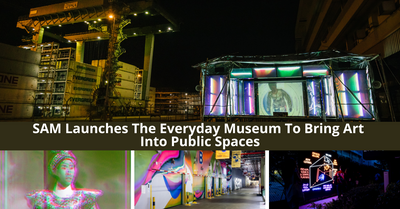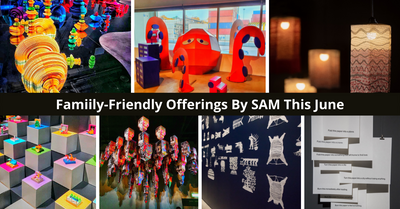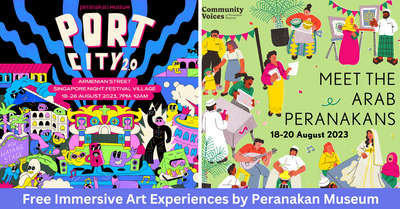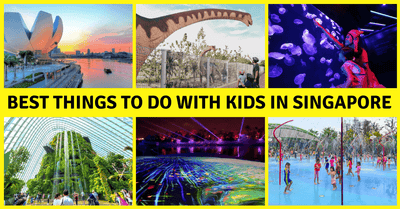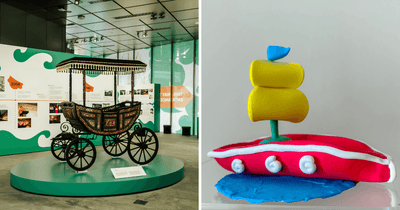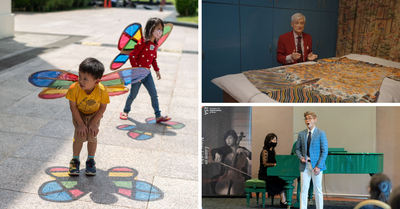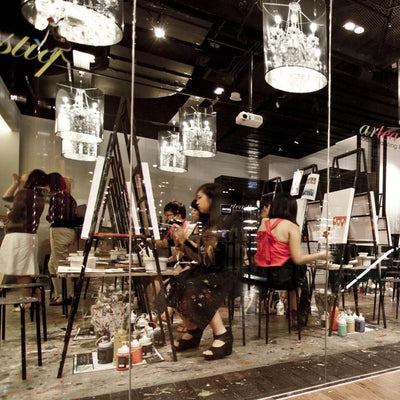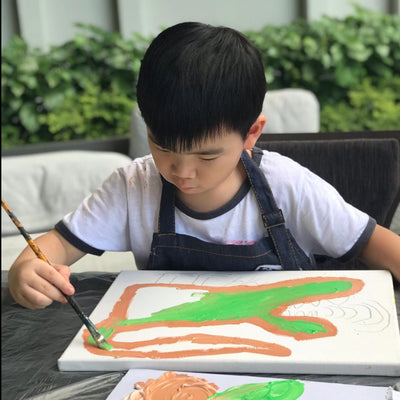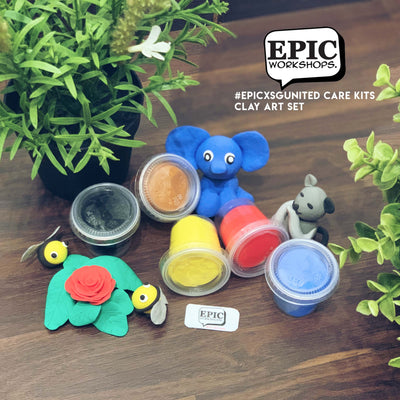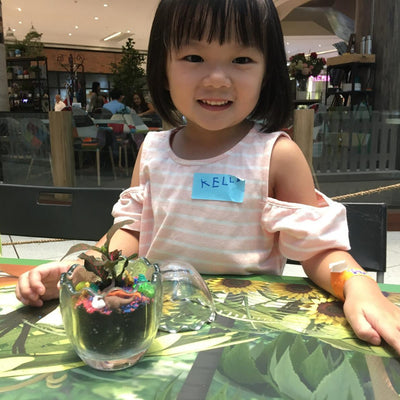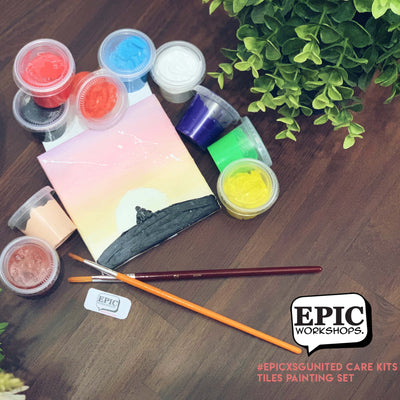Singapore Art Museum (SAM) has launched its newest exhibition, along with several free programmes that are suitable for all ages!
About The Exhibition: Can Everybody See My Screen?

Photo Credit: Singapore Art Museum
Venue: SAM at Tanjong Pagar Distripark
Date: 9 Sep to 11 Dec 2022
Time:
Fee: Free admission
SAM invites visitors to explore how our bodies negotiate and connect with technology at its latest exhibition "Can Everybody See My Screen?".
Referencing an oft-repeated phrase that emerged from a long period of remote interactions, SAM’s new exhibition reflects on how our understanding of lived realities has shifted with the rise and changes in digital technologies over the last two decades.
Free Programmes
Venue: SAM at Tanjong Pagar Distripark
Date: 17 Sep 2022
Time: Various timings
Fee: Free admission
In line with the exhibition, SAM has also lined up several public programmes that are entirely free for all to join, and are suitable for everyone of all ages and backgrounds!
From craft activities to performances, there's something for everyone to enjoy! Taking place on 17 September 2022, here's what you and your family can expect at SAM at Tanjong Pagar Distripark:
[Drop-in Activity] Create Your Own Hama Beads Pixel Art

Photo Credit: Singapore Art Museum
Venue: The Engine Room, SAM at Tanjong Pagar Distripark
Date: 17 Sep 2022
Time: 1pm to 5pm
Fee: Free admission
Create your very own pixel bead art! Choose from four templates and personalise your design with colourful Hama beads.
[Drop-in Activity] Create Your Own Emoji

Photo Credit: Singapore Art Museum
Venue: The Engine Room, SAM at Tanjong Pagar Distripark
Date: 17 Sep 2022
Time: 1pm to 5pm
Fee: Free admission
Which emoji best represents you? Design your very own emoji based on the 8-bit visual form of old-school arcade video games, inspired by Terra Bajraghosa's Narcissus Pixelus.
[Tour] Can Everybody See My Screen?: A Curator-led Tour

Photo Credit: Singapore Art Museum
Venue: Gallery 2, SAM at Tanjong Pagar Distripark
Date: 17 Sep 2022
Time: 4pm to 4.15pm
Fee: Free admission
Join SAM Curator Teng Yen Hui as she shares about the processes behind selected artworks in the exhibition, "Can Everybody See My Screen?", which looks at the various ways in which artistic practices engage with an increasingly digitalised world.
[Performance] Performance activation of Trace2 by Teow Yue Han

Photo Credit: Singapore Art Museum
Venue: Gallery 2, SAM at Tanjong Pagar Distripark
Date: 17 Sep 2022
Time: 2pm to 3.30pm
Fee: Free admission
"Trace2" explores the lingering presence of TraceTogether and the layers of geofencing, bio-surveillance and new forms of life that might emerge, especially with those that arise from the gradual decommissioning of the contact tracing system.
The performance activation of "Trace2" brings together artwork collaborators Bernice Lee and Federico Ruberto, who creates the live movement augmented by text and sounds with a self-trained model (IA-AI) and a modular synthesiser, transforming the exhibition space into a site of transmission and symbiosis – inviting the audience to interact with "Trace2" and generate new forms of collective intelligence.
Exhibition Artworks
As the name of the exhibition suggests, the space of the screen is central to the exhibition, acting as a portal through which experiences of the world are mediated by technology.
Drawing from works created post2000, "Can Everybody See My Screen?" examines the various ways in which artistic practices engage with an increasingly digitalised world and expounds on humanity’s shared encounters with evolving technology in contemporary times.
Building upon a thematic selection, the exhibition will feature the works of local and regional artists from Indonesia, Malaysia, Thailand, and China. Seven of the 12 works presented are from SAM’s collection, reflecting the museum’s efforts to collect and engage with new mediums and modes of artmaking. These works are brought into dialogue with four commissions and one loan, presenting shifting perceptions towards technology’s impact on contemporary life.
Here are some of the artworks that you can look forward to:
Terra Bajraghosa - Narcissus Pixelus (2009)
![]() Photo Credit: Terra Bajraghosa & Singapore Art Museum
Photo Credit: Terra Bajraghosa & Singapore Art Museum
"Narcissus Pixelus" draws on the visual form of arcade video game machines. The video game arcade was a common sight around the world until its popularity waned at the turn of the millennium. It represents a youth culture and a social space where excelling in these games was a form of self-affirmation and a way to establish recognition among peers. The game in "Narcissus Pixelus" is neither a game of skill nor of chance. Instead, it invites players to create their idealised digital self by using a swatch of pixelised styles or templates created by the artist. Here, the artist’s pixel differs from an actual pixel— referring to a neutral sampling of a digital image—as they are styled with preconceived visual patterns that represent something, such as a limb or accessory. Though these selfies are seemingly unique, upon close scrutiny they are all limited by the fixed style palette. As the title suggests, the obsession with taking selfies translates into an obsession with the digital ideal, in which the freedom of choice is mistaken for autonomy.
Chatchai Puipia - Windows (Love Me...Love Me Not...Love Me) (1997)

Photo Credit: National Heritage Board
In "Windows (Love Me…Love Me Not...Love Me)", the artist is depicted as a naked and androgynous figure, appearing to be forlorn and submissive while dressed in exotic, feminised embellishments. Created during a period when the rise of the global internet offered a boost to the centuries-old international marriage brokering service, this work can be seen as a biting commentary of the uneven power distribution that underpins the phenomena of mailorder spouses and internet dating. Framed in the form of a browser window, the figure is painted larger-than-life, and harks back to the retail shop window—where the guise of online sociability is peeled off to reveal the passive commodification underlying cyber relationships.
Chong Kim Chiew - Unreadable Wall (2013)

Photo Credit: Chong Kim Chiew
"Unreadable Wall" is an installation comprising hundreds of bricks made out of shredded and pulped newspaper sheets from Malaysia’s vernacular papers. Presented in this form, they are rendered—as the work’s title suggests—unreadable, and thus impotent. Arranged in a way that deliberately obstructs the gallery’s original entrance, the work acts as a screening device that forbids bodies from entry—a metaphor for the limited press freedoms experienced in the artist’s home country.
Extending this line of thought to online news platforms and cyberspace, the work stands as an ideological symbol for the disruption of free information flow, as well as other fragmentary pressures that endanger the globalised, interconnected space of the internet. These include technological changes, geopolitical developments, and commercial practices. Meanwhile, a confrontation with the physicality of the wall brings us back into awareness of our own corporeality and of the bodies we still inhabit on the other side of a digital screen.
Choy Ka Fai - Prospectus for a Future Body (2010-2012)

Photo Credit: Choy Ka Fai
"Prospectus for a Future Body" proposes new perspectives on how the body remembers and invents technological narratives. Central to the project is the study of body movement in dance: how can it evolve, adapt or recondition to possible futures? While Choy was a student at London’s Royal College of Art, he developed a number of performances and demonstrations that investigated technology’s potential to mechanically map, store and transfer movements. By translating those movement “memories” back to the body via wired, electrical impulses, the artist redefines the relationships between choreographer, dancer and audience. Thus, the work questions whether we can design “future memories” for our bodies, and if we can consider the body as the source, repository, receptacle and medium for moments, past and future.
"Prospectus for a Future Body" is an early exploration by Choy of the transformative impact of technology on the relationship between the body, time and space, especially that of the internet and the digital/virtual realm. Collaborating with scientists and engineers, the work is an investigation into the triggers of emotion in the time-space between reality and virtuality.
Muhammad Akbar - Il Fait Bleu (2014)

Photo Credit: Muhammad Akbar
While on residency at La Rochelle, France, Akbar was struck by the shade of blue of the evening sky in France. To him it recalled the digital blue field or screen, the backdrop against which all manner of special effects can be created. It is also what one sees when there is a lack of a signal. This “blank slate” and suggestion of disconnection became an apt metaphor for the artist’s experience of being in a foreign place. "Il Fait Bleu" captures the changing sky, from sunrise to sunset. Immersed under the changing blue lights, it invites one to de/attach with their environment and engage in an exercise in meditative gazing. Hints of La Rochelle’s historic and classical architecture frame the patch of sky, creating the illusion of being in an enclosed courtyard, as if the viewer is standing there beholding a piece of heaven.
Urich Lau - Code File: Three Domes (2016)

Photo Credit: Urich Lau
"Code File: Three Domes" presents a trio of domes that feature prominently in the architecture of major cultural institutions in Singapore. Yet, there is an ambivalence that is present in their error-strewn appearances. The glitching observed brings forth a subtle disquiet—like a television screen that is about to lose its signal, or a temporarily malfunctioning electronic device, simultaneously piquing the interest of the viewer while also subverting its subjects’ own confidence.
Reflecting on the nature and inherited histories of the arts ecosystem in Singapore, the artist has tampered with the digital code files of the photographs, mischievously inserting aspirational statements from the national arts agency into the source material to render the final images in unexpected ways. While these words represent the hopes and ambitions for the local arts scene, their interference within the code files generates an altered image, ruining the integrity of the original photographs. With this, Lau draws heavily upon the aesthetics of disruption to question structures of power and their lingering effects.
Urich Lau - Life Circuit (2009-2016)

Photo Credit: Urich Lau
"Life Circuit" was originally conceived as a video demonstration centred around a wearable device that was reconstructed from industrial safety equipment. When donned by the artist and activated, the modified gadgets become extensions of a body that is now hindered from seeing, speaking, or hearing, yet able to stream out audio and video feeds captured from his immediate surroundings. Presented here as a multimedia installation, audiences encounter live projections of themselves as captured by the spy cams on the device. However, their images quiver and convulse from the overwhelming amount of input channelled through this singular device.
"Life Circuit" reflects on the condition of living in a Singapore that is technologically advanced, as well as its attendant issues of privacy, data collection, and the trading of human touch for digital capabilities. By design, the equipment is supposed to enable its user, but it has been functionally altered and worn by the artist in a manner that restricts his senses instead. The system of spy cams that have been turned into a live feed plays on the human impulse for self affirmation in our own images, unwittingly facilitating data collection and invading our privacy while disguised under the cloak of entertainment.
Liana Yang - A Souvenir (2022)

Photo Credit: Liana Yang
"A Souvenir" looks at the factors of choice and chance as the key ingredients to the success or failure of online dating and romantic relationships. With online dating, the influx of choice and chance can also be paradoxically challenging to navigate. Chance is an emotion that is full of hope, and many of those who feel bored or lonely are compelled to find “the one” via dating apps. Yet, online dating users assume they are in control when much of the mechanisms are in fact controlled by the app’s algorithms. Choice and chance thus become a game of luck, a mechanism which is explored by the artist through the metaphor of the claw machine. The claw machine’s monitor also extends Yang’s interest in contemporary cultures and photography theories that examine our attachments with social apps and online media, tapping onto the visual and textual tropes of romance, seduction and intimacy.
Teow Yue Han - Trace2 (2022)

Photo Credit: Teow Yue Han
"Trace2" explores the lingering presence of TraceTogether and the layers of geofencing, bio-surveillance and new forms of life that might emerge, especially with those that arise from the gradual decommissioning of the contact tracing system. In collaboration with a dancer and research writer, this speculative installation incorporates a motion sensor activated tracing system that explores postpandemic traumas, rehabilitations and a newfound understanding of both physical and digital spaces. "Trace2" is a continuation of Performing the Smart Nation, an ongoing body of work by Teow that seeks to engage the corporate vision of the Smart Nation by finding new performance strategies within choreography. The work reimagines the embodied experience and conditioned habits of society by transforming the exhibition space into a playful site of transmission and collaboration.
Xafiér Yap - 2nd Puberty (2022)

Photo Credit: Xafiér Yap
Taking the form of a 2D videogame, "2nd Puberty" is an experiential work that considers gaming as a portal through which to reimagine time, space and ways of being. Set within the intimate space of a desk-gaming set-up, audiences access the game via a tattooed MacBook Pro. They are invited to take on the perspective of an avatar in order to navigate the virtual world, the judgment of others, and their own inner dialogue. Subverting traditional storylines and game mechanics, the work draws upon the experience of living and transitioning in a heteronormative society. Tapping on the propensity of video games for world-building and discovery, Yap constructs a space where the virtual is not viewed in opposition to the “real,” but rather as a constituent of it. In the process, the work introduces new ways to connect, communicate, and to understand each other and ourselves.
KYTV - The P.O.P. Station Greatest Hits (2004-2009, 2022)

Photo Credit: KYTV
Long before the dawn of Tiktok, there was "The P.O.P. Station" by KYTV (with “P.O.P.” standing for “Politics of the Popular”). Originally presented as an interactive work between 2004–2009, audiences were invited to make and star in music videos set to soundtracks and backdrops created by the collective. The previous iteration of the work was a satirical response to a music business which favoured formulaic approaches to manufacturing marketable pop stars. KYTV envisioned the decentralisation of pop culture instead, and assisted aspiring performers by providing them with the necessary tools via The P.O.P. Station. The resulting music videos were then uploaded to YouTube in hopes of achieving fame through the platform’s potential for broadcast and virality.
This year, "The P.O.P. Station" returns with its latest iteration, Greatest Hits—a vibrant, multimedia presentation tracing the journey of KYTV’s creative endeavour. Featuring a video wall of self-made stars and an accompanying mockumentary of the work’s evolution, "The P.O.P. Station" exemplifies the early beginnings of social networking sites while acknowledging the role and dreams of ordinary citizens, as well as the Internet’s shared humanity.
Cao Fei - i.Mirror (2007)
![]()
Photo Credit: Cao Fei, Vitamin Creative Space and Sprüth Magers
It’s perhaps no longer important to draw the line between the virtual and the real, as the border between the two has been blurred. In the virtual land, we are not what we originally are, and yet we remain unchanged. We always worry about the virtual space’s erosion of reality, but hopefully there’s new possibility of combination in our electronic second life, a new force which transcends this mortal coil. On the reality’s end of this combined ultraspace there is still love for simplicity and the pursuit of freedom. God loves people, but we are also each other’s salvation.


